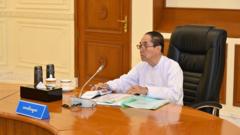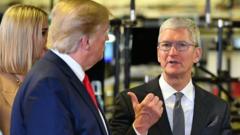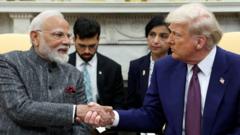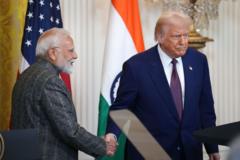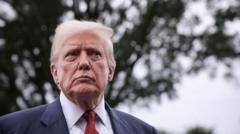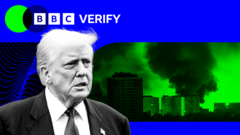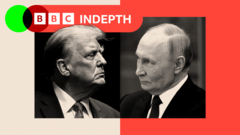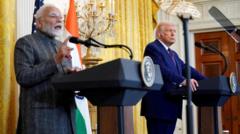US President Donald Trump has officially initiated a series of pronounced tariffs impacting nations worldwide, igniting significant reactions across global markets.
Trump's Major Tariff Reforms Hit Global Trade Landscape

Trump's Major Tariff Reforms Hit Global Trade Landscape
New tariffs imposed by Trump's administration target multiple countries, reshaping international trade dynamics.
Trump's administration has ushered in a set of sweeping tariffs that affect numerous countries beginning today. "IT'S MIDNIGHT!!! BILLIONS OF DOLLARS IN TARIFFS ARE NOW FLOWING INTO THE UNITED STATES OF AMERICA!," the President declared on social media moments before the midnight deadline in Washington, DC. Among the new measures is a substantial 50% tariff on India, which will remain unless the country ceases its purchases of Russian oil.
The administration has also threatened a staggering 100% tariff on foreign-manufactured semiconductors as part of efforts to drive technology firms back into the US. This ultimatum accompanied Apple's announcement of a $100 billion U.S. investment, acknowledged by many as a response to heightened White House demands for American production initiatives.
Recent alterations to the trade policy underline Trump's vision of reforming a global trading system he perceives as inequitable toward the US. Export-centric economies in Southeast Asia are particularly vulnerable, facing levies as high as 40% in countries like Laos and Myanmar. Evidently, some analysts suggest these tariffs strategically target nations with strong commercial relations with China.
Further developments reveal that several key economies—including the UK, Japan, and South Korea—have successfully negotiated their tariff rates down, securing better terms than were initially proposed in April. The European Union, in a remarkable pivot, agreed to framework terms with the US, accepting a lowered 15% tariff on its exports.
Taiwan, an important ally, has been assigned a temporary 20% tariff, as President Lai Ching-te elucidated ongoing negotiations with the US for a revised rate.
In a noteworthy twist, Trump's recent actions included an elevation of Canada's tariff from 25% to 35%, following claims of inadequate cooperation in addressing drug-related issues at the border. However, due to the existing USMCA trade agreement, most Canadian products will remain exempt from these import taxes. Meanwhile, discussions for a new trade deal have temporarily halted higher tariffs on Mexico for an additional 90 days.
Reactions to the altered trade landscape have varied widely, with businesses globally expressing shock and relief at the newly established tariffs. Reports suggest that major semiconductor manufacturers, essential to the US economy, like TSMC, SK Hynix, and Samsung, have secured exemptions from the looming tariffs, further complicating the narrative around this new policy.
As Trump continues to negotiate with China, talks will resume regarding a temporary 90-day tariff extension set to expire on 12 August, heralding a critical juncture in international trade relationships ahead.
The administration has also threatened a staggering 100% tariff on foreign-manufactured semiconductors as part of efforts to drive technology firms back into the US. This ultimatum accompanied Apple's announcement of a $100 billion U.S. investment, acknowledged by many as a response to heightened White House demands for American production initiatives.
Recent alterations to the trade policy underline Trump's vision of reforming a global trading system he perceives as inequitable toward the US. Export-centric economies in Southeast Asia are particularly vulnerable, facing levies as high as 40% in countries like Laos and Myanmar. Evidently, some analysts suggest these tariffs strategically target nations with strong commercial relations with China.
Further developments reveal that several key economies—including the UK, Japan, and South Korea—have successfully negotiated their tariff rates down, securing better terms than were initially proposed in April. The European Union, in a remarkable pivot, agreed to framework terms with the US, accepting a lowered 15% tariff on its exports.
Taiwan, an important ally, has been assigned a temporary 20% tariff, as President Lai Ching-te elucidated ongoing negotiations with the US for a revised rate.
In a noteworthy twist, Trump's recent actions included an elevation of Canada's tariff from 25% to 35%, following claims of inadequate cooperation in addressing drug-related issues at the border. However, due to the existing USMCA trade agreement, most Canadian products will remain exempt from these import taxes. Meanwhile, discussions for a new trade deal have temporarily halted higher tariffs on Mexico for an additional 90 days.
Reactions to the altered trade landscape have varied widely, with businesses globally expressing shock and relief at the newly established tariffs. Reports suggest that major semiconductor manufacturers, essential to the US economy, like TSMC, SK Hynix, and Samsung, have secured exemptions from the looming tariffs, further complicating the narrative around this new policy.
As Trump continues to negotiate with China, talks will resume regarding a temporary 90-day tariff extension set to expire on 12 August, heralding a critical juncture in international trade relationships ahead.


